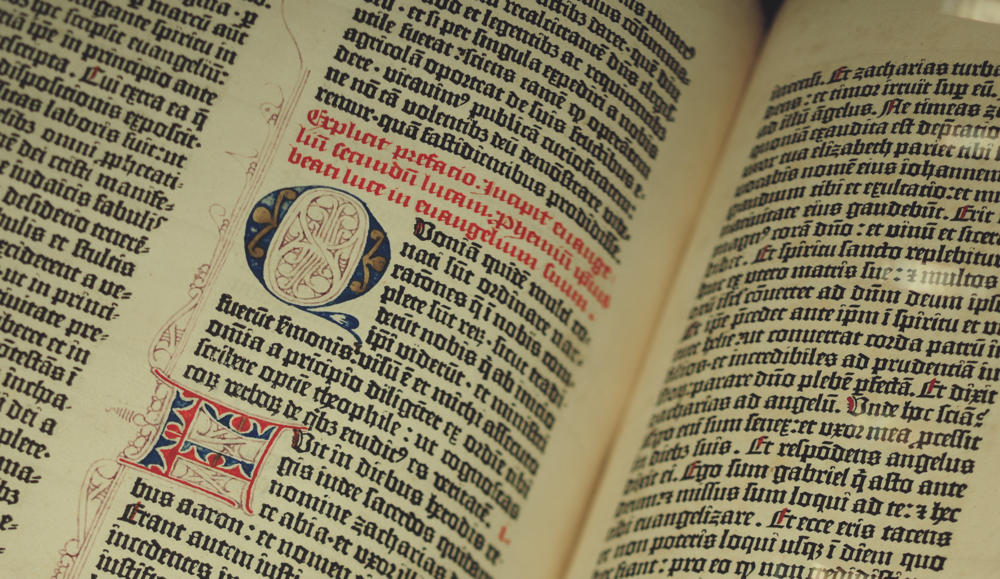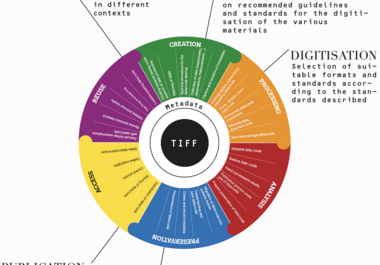NFDI4Culture Use Case
Gutenberg goes Culture: How the Gutenberg Museum benefits from NFDI4Culture's expertise and offerings during its digitization campaign
Keywords

Detail der 42-zeiligen Gutenberg-Bibel (Shuckburgh-Exemplar)
"Opened Gutenberg bible with miniatures." © Gutenberg-Museum Creator: Carsten Costard
As a world museum of printing art, the Gutenberg Museum in Mainz is facing a transformation process in the coming years: How can knowledge about Johannes Gutenberg and his groundbreaking invention be made accessible in the digital world?
A central question is how the approximately 500,000 objects in the collection of the museum can be captured digitally and linked. The huge amount of different holdings, including books, type samples, coins, and printing presses, poses a particular challenge. Fundamental considerations arise: Which database is most suitable? What data should be considered during recording, what is the best approach? Additional questions concern the technical prerequisites and the reusability of the digital inventory.
Whether it be questions about digitization, the application of data standards, the use of specific software, or clarifying legal questions: NFDI4Culture supports the conception of the Gutenberg Museum's digitization campaign with tailored consutling and advice.
The NFDI4Culture Helpdesk has been of great assistance to us on several occasions. With this support, we were able to, for example, further specify our requirements for a collection database.

Esther Klippel | Gutenberg-Museum
Digitalisation holds significant importance for the future in the world of museums. In developing our digital strategy, we find NFDI4Culture to be a crucial contact for our queries.

Dr. Ulf Sölter | Gutenberg-Museum
With its digital vision for the future, the Gutenberg Museum aims not only to preserve the knowledge of Johannes Gutenberg and the impacts of his invention but also to bring it to life in a globalized digital world. For this purpose, around 500,000 objects will be digitized, including one of the largest libraries in Germany on the history of books, printing, and writing, with 95,000 books. With graphics ranging from Exlibris (labels or stamps glued into the book as ownership marks) to posters, incunabula (early printed works before 1500), type samples, coins, printing presses, and printing forms, the collection is extensive.
In developing a digitization strategy, it soon became clear that the existing workflows could not meet the museum's future requirements. More adequate solutions which also enable external visibility of the collection, need to be found. Which database is best suited for capturing the collection? Which standards need to be considered during the recording? How can object data be integrated on well-known portals like the DDB? How can the FAIR principles be implemented?
To kick off the digitization project, the museum organised a two-day event in January 2023 with around 20 colleagues from museums, libraries, and archives. Among them were also some experts of NFDI4Culture. Fruitful exchanges about the project's particular challenges led to the first concrete ideas for strategic approaches. It became clear that it will need good, solid preparation to be successful.
Currently, various collection databases and recording devices are being examined, and the necessary IT and spatial conditions for digitisation are being clarified. The NFDI4Culture Helpdesk is assisting in specifying the requirements for a collection database and is developing a set of recommendations tailored to the needs of the Gutenberg Museum. It also advises on the optimal design and equipment on premises for digitisation. Participation in the NFDI4Culture Community Plenary in March this year allowed the museum team to engage with various specialists and infrastructure providers of the consortium.
The Gutenberg Museum continues to maintain close contact with NFDI4Culture and regularly makes use of the services provided by the consortium.








